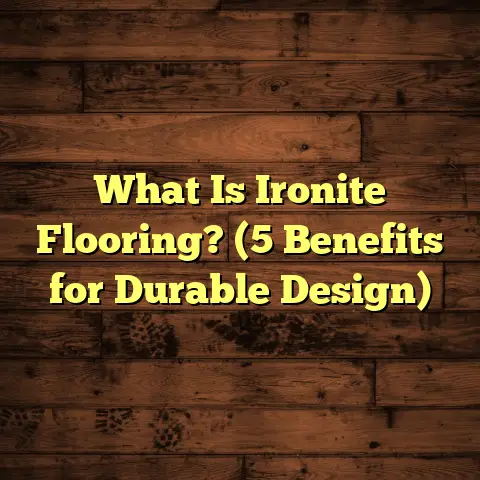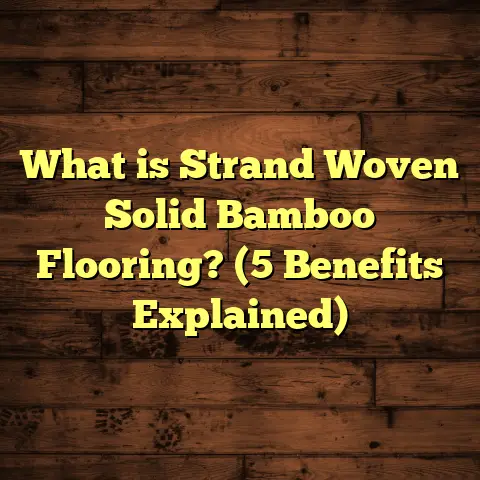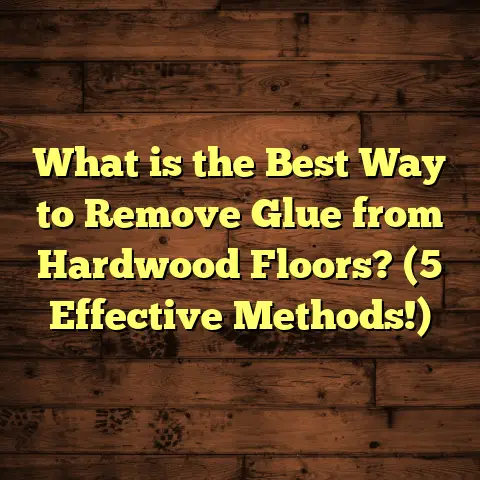What is Engineered Flooring vs. Laminate? (5 Key Comparisons Revealed)
“The details are not the details. They make the design.” – Charles Eames
This quote always strikes a chord with me, especially when people ask me about flooring options like engineered flooring and laminate. At first glance, these two can seem quite similar—both offer a wood-like look and feel—but trust me, the differences go way beyond appearances. Over years of working in this industry, I’ve learned that the right flooring choice isn’t just about looks; it influences your budget, durability, maintenance needs, and even your home’s value.
So, what really sets engineered flooring and laminate apart? Let me walk you through this with insights, numbers, personal experiences, and even some case studies I’ve gathered along the way.
What Are Engineered Flooring and Laminate? Understanding the Basics
Let’s get this straight from the start: engineered flooring and laminate flooring are two very different products, built differently and used in different ways.
Engineered Flooring Explained
Engineered flooring is a hybrid product combining real hardwood with layers of plywood or high-density fiberboard (HDF). The top layer—which is real hardwood veneer—is usually between 1mm to 6mm thick, although most residential products fall around 3mm. The core underneath is made with multiple layers of plywood glued together in alternating grain directions. This structure gives the floor extra stability compared to solid hardwood.
The thickness of engineered flooring varies but typically ranges from 12mm to 20mm overall. The combination of real wood on top with a multi-layered core means it behaves more predictably with temperature and humidity changes, reducing the risk of warping or cupping.
I remember when I first worked on a project in the Pacific Northwest—a region with high humidity swings. The client wanted hardwood floors but worried about moisture damage. Installing engineered flooring was an ideal solution that held up beautifully for years.
Laminate Flooring Explained
Laminate flooring is a completely man-made product designed to mimic the appearance of wood (or stone or tile). It consists of several layers:
- A wear-resistant surface layer made from melamine resin or aluminum oxide.
- A design layer, which is a high-resolution photographic image replicating wood patterns.
- A core layer made from high-density fiberboard (HDF).
- A backing layer to balance the floor and add stability.
Typical laminate plank thickness ranges from 6mm to 12mm, making it thinner on average than engineered flooring.
Unlike engineered flooring, laminate contains no real wood veneer on top—it’s all synthetic. That means it doesn’t have the same texture or natural grain depth but often comes in a wide variety of colors and styles at a fraction of the cost.
How I Came Across Both
Early in my flooring career, I was called to replace floors in an older home where moisture damage had ruined laminate floors installed by previous owners. I switched to engineered flooring for their next renovation—and that experience showed me how important material choice can be, especially in tricky environments like basements or kitchens.
1. Material Composition and Durability
The materials inside engineered and laminate floors directly impact how they handle wear, moisture, and aging.
Engineered Flooring Materials in Detail
- Top veneer: Real wood (oak, maple, walnut, hickory, etc.) ranging 1mm–6mm thick.
- Core: Multiple layers of plywood or HDF glued crosswise for strength.
- Backing: Balancing layer to prevent cupping.
This is why engineered floors are often recommended for below-grade installations like basements or areas prone to moisture fluctuations.
In terms of durability: the thicker the veneer, the more times you can sand and refinish it—usually once or twice for 2mm–3mm veneers and up to five times for 6mm veneers.
Laminate Flooring Materials in Detail
- Wear layer: Transparent melamine resin or aluminum oxide coating providing scratch resistance.
- Design layer: High-quality photographic image printed on paper.
- Core: High-density fiberboard (HDF) made from wood fibers compressed with resins.
- Backing layer: Balancing layer for moisture resistance and stability.
Laminate’s synthetic wear layer makes it highly resistant to scratches and dents. However, if water penetrates seams or edges, swelling and delamination can occur.
Durability Comparisons
| Feature | Engineered Flooring | Laminate Flooring |
|---|---|---|
| Scratch Resistance | Moderate (depends on finish) | High (melamine resin surface) |
| Water Resistance | Moderate (some products have better finishes) | Low to Moderate (vulnerable to moisture) |
| Refinishing Capability | Can be sanded/refinished 1–5 times | Cannot be refinished |
| Lifespan | 20–30+ years | 10–20 years |
My Experience With Durability
In a family home near Seattle with kids and pets, I installed laminate flooring around 15 years ago. For the first decade, it held up well against scratches but started showing wear around edges after water spills. Meanwhile, engineered floors I installed nearby showed minor scuffs but could be refinished to look almost new after 15 years.
2. Cost Differences and Budget Considerations
Money talks—let’s get into how these two options stack up financially.
Engineered Flooring Cost Breakdown
Material prices vary widely depending on species and veneer thickness:
- Basic oak engineered flooring: $6–$8 per sq ft
- Mid-range exotic species or wider planks: $8–$12 per sq ft
- High-end options (thicker veneer, premium species): $12–$20+ per sq ft
Installation costs depend on method:
- Floating installation: $3–$4 per sq ft
- Glue-down or nail-down: $4–$6+ per sq ft
For an average 1,000 sq ft room, total costs range from $9,000 to $18,000 depending on product quality and installation complexity.
Laminate Flooring Cost Breakdown
Laminate is generally cheaper upfront:
- Low-end laminate: $1.50–$2 per sq ft
- Mid-range laminate: $2–$3 per sq ft
- High-end laminate (waterproof options): $3–$4+ per sq ft
Installation is typically faster and simpler:
- DIY-friendly floating installation: $2–$4 per sq ft
- Professional install: similar range but easier than hardwood methods
Total cost for 1,000 sq ft ranges from $3,500 to $8,000.
How I Use FloorTally for Cost Planning
Estimating costs used to be time-consuming until I started using FloorTally. It lets me input local labor rates and material prices for precise budgeting. The tool also adds waste factors—usually around 5%–10%—which helps avoid last-minute surprises from cutting around doorways or odd-shaped rooms.
For instance, I once managed a condo renovation in Chicago covering 1,200 sq ft. Using FloorTally saved me hours calculating costs for both laminate and engineered options so I could quickly provide my client with solid quotes.
3. Installation Techniques and Timeframes
Installation differences affect how long projects take and who can do them.
Engineered Flooring Installation Details
Engineered flooring can be installed in several ways:
- Nail-down: Fastens planks to wood subfloor; common with thicker planks.
- Glue-down: Adhesive applied directly to concrete or plywood.
- Floating: Boards click together over underlayment without fasteners.
Before installation, engineered wood needs acclimation—usually 48–72 hours—to adjust to room temperature and humidity. This reduces gaps or buckling later.
Installation time depends on method and size:
- For a typical 1,000 sq ft room, expect 3–5 days including prep work.
- Complex layouts or repairs may add time.
Laminate Flooring Installation Details
Laminate is almost always installed as a floating floor with click-lock planks:
- No nails or glue needed—boards snap together easily.
- No acclimation required; installation can begin immediately.
- Underlayment is placed first for sound insulation and moisture barrier.
Because it’s simpler to install, laminate projects usually finish faster:
- Average time for 1,000 sq ft: 1–2 days.
Real-Life Timing Stories
I once had a client needing floors installed quickly before moving day. We chose laminate because it could be installed over two days without waiting for acclimation—perfect for their tight timeline.
Conversely, a custom home I worked on in Denver took nearly a week for engineered floors due to complex patterns and glue-down method.
4. Appearance and Aesthetic Appeal
How much do these floors look like “real” hardwood? Let’s talk visuals.
Visual Characteristics of Engineered Flooring
Since engineered flooring uses real hardwood veneers:
- You get natural wood grain variations.
- Planks have authentic texture with knots and pores.
- Colors deepen naturally over time.
- Can be stained or refinished like solid hardwood (depending on veneer thickness).
Plank widths vary from narrow strips (~3”) up to wide planks (7”+), allowing customization for traditional or modern styles.
Visual Characteristics of Laminate Flooring
Laminate flooring relies on printed images:
- Designs have improved drastically with high-res printing.
- Options include oak, maple, hickory, exotic woods—even stone patterns.
- Surface texture attempts wood grain replication but lacks depth.
- Colors tend to be more uniform across planks.
Laminate often uses bevel edges for a more realistic plank look but doesn’t have the natural imperfections of real wood.
Personal Stories About Appearance
I had a couple torn between these two options who wanted authentic looks but had budget constraints. We settled on engineered oak with a 3mm veneer—it gave them natural warmth without costing as much as solid hardwood.
One client loved their laminate floor’s consistent color but admitted they missed the “feel” of real wood underfoot after a few months.
5. Maintenance Requirements and Longevity
You want floors that survive daily life without constant fuss.
Maintaining Engineered Floors
- Sweep or vacuum regularly to remove dirt/grit that can scratch.
- Use damp mop with hardwood-approved cleaners; avoid excess water.
- Refinish every 10–15 years if veneer is thick enough (2mm+).
- Watch for dents near heavy furniture; use protective pads.
With good care, engineered floors last 20–30 years or more.
Maintaining Laminate Floors
- Sweep/vacuum regularly.
- Clean spills immediately using damp cloth; avoid standing water.
- Use manufacturer-recommended cleaning agents—avoid wax or polish.
- Cannot be refinished; damaged planks must be replaced.
- Lifespan typically ranges from 10–20 years depending on quality and traffic.
My Experience With Maintenance
In one house with young kids and dogs, laminate held up well initially but showed edge swelling after water spills over years. In contrast, another family used engineered floors successfully for over 15 years with minimal refinishing needed—only occasional scratches near entryways.
Additional Insights From Case Studies I’ve Collected
Case Study: Moisture Challenges in Florida Coastal Home
I installed engineered flooring in a Florida beach house prone to high humidity and occasional flooding during storms. Thanks to plywood core construction and real wood veneer acclimated properly over 72 hours before installation, the floor remained stable after three hurricane seasons—not a single plank warped or buckled.
A nearby neighbor had installed laminate floors in their vacation home; after two years of moisture exposure near windowsills and kitchen areas, several boards swelled requiring replacement—costly and frustrating for them.
Case Study: Budget Renovation in Midwestern Apartment
A client renovating a rental unit opted for laminate due to budget constraints ($1.80/sq ft material cost). Installation took just under two days with no professional help required. The floor held up well under tenant use for four years before showing surface wear but was easy to replace at end of lease cycle without major expense.
How Location Impacts Your Choice Between Engineered Flooring vs Laminate
Where you live plays a huge role in which material will work best:
| Location Type | Recommended Flooring Type | Reason |
|---|---|---|
| Humid climates (Florida, Gulf Coast) | Engineered flooring | Resists moisture better than laminate |
| Dry climates (Arizona, New Mexico) | Either option works | Low moisture risk reduces warping |
| Basements | Engineered flooring | Better dimensional stability |
| Rental properties | Laminate | Budget-friendly; easy replacement |
| High traffic commercial spaces | High-quality laminate | Scratch resistance; lower maintenance |
Design Trends That Matter in Flooring Choices Today
I’ve noticed some shifts in what clients want aesthetically:
Wider Planks: Both engineered floors and laminates now come in wider planks (up to 7 inches) which make rooms feel larger and more modern.
Gray & Whitewashed Tones: Popular in coastal or Scandinavian designs; both materials offer these finishes though engineered looks more natural.
Textured Surfaces: Wire-brushed or hand-scraped textures are possible only with real wood veneers in engineered floors—not laminate.
Eco-friendly Materials: Engineered wood from sustainably harvested forests appeals more than laminate which relies on synthetic resin layers.
Environmental Impact: Which Is Greener?
Sustainability matters more every year. Here’s what I tell clients:
- Engineered flooring uses real wood veneers often sourced from certified forests (FSC-certified).
- Plywood cores are also renewable but do involve adhesive resins.
- Laminate relies heavily on synthetic materials (melamine resin) derived from chemicals—not biodegradable.
- End-of-life disposal differs: engineered wood can sometimes be recycled; laminate usually ends up in landfill due to glue/resin layers.
If you’re environmentally conscious, engineered flooring generally has less chemical content but check product certifications closely.
Final Thoughts — Which One Is Right For You?
Choosing between engineered flooring and laminate isn’t just about price or looks—it’s about what fits your lifestyle best:
Ask yourself:
- How much wear will my floor see?
- Do I want authentic wood look & feel?
- What’s my budget ceiling?
- How important is moisture resistance?
- Can I install myself or hire pros?
- What’s my timeline?
For long-term durability combined with real wood aesthetics—especially in humid areas—I lean towards engineered flooring almost every time. But if cost efficiency, fast DIY installation, and scratch resistance are priorities—and you’re okay without genuine wood—laminate is an excellent choice.
Using tools like FloorTally has been a game-changer for me professionally. It lets me input localized data including labor rates and materials costs so clients get realistic budgets upfront. That prevents surprises later down the road—and everyone appreciates transparency.
If you want help estimating costs tailored to your space or need guidance selecting materials based on your lifestyle and location, just ask! Flooring isn’t just covering your floors—it’s about creating a foundation that fits your life perfectly over many years ahead.
Thanks for sticking with me through this deep look at engineered versus laminate flooring! What questions do you have next?





